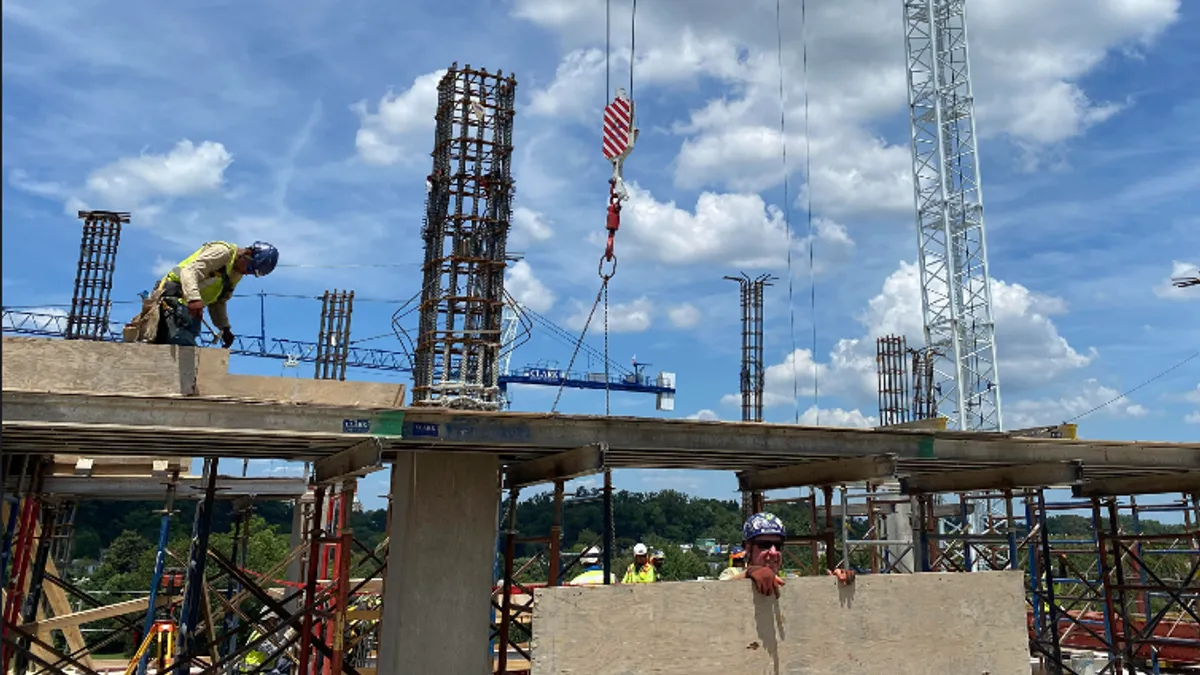When it opens in 2023, a new healthcare facility for MedStar Georgetown University Hospital in Washington, D.C., will feature the latest medical and technological advances.
The new 477,213-square-foot medical and surgical building will feature 156 patient rooms, 32 exam rooms and a rooftop helipad with direct access to 31 operating rooms. An intraoperative MRI system with a ceiling-mounted rail system connecting the diagnostic room and adjacent operating rooms will bring the MRI magnet directly to the patient. In addition, the project includes a 600-car, below-grade parking garage, 18 elevators and 6 acres of new green space.
The site is on the land of the former Kober-Cogan Building, which was shut down in May 2010 after the discovery of mold in the building and previously had housed the hospital's psychiatry department.
That presented unique challenges for the project team, led by Bethesda, Maryland-based Clark Construction. Miles of water utility lines, many of which were not documented, were running directly under the location of the new pavilion to feed both MedStar Georgetown University Hospital and the Georgetown University campus buildings. The project team had to relocate these utilities outside of the building footprint to allow the project to begin.
"The Clark team designed and engineered a 250-foot-long utility bridge to support chilled water and electrical services from the central utility plant to the existing MedStar Georgetown Hospital," said Bradley Hunter, project executive at Clark Construction Group. "The bridge installation required close coordination with mechanical and electrical contractors who installed the utilities on prefabricated racks which were then hung from steel beams measuring 60 feet, allowing excavation to begin below."
Clark Construction, along with architects HKS and Shalom Baranes Associates, assembled a BIM model of the existing utilities. As design progressed and the basic structure and caisson locations were set, "we performed additional borings at all caisson locations and further informed the BIM excavation model," said Hunter.
This initial step allowed the Clark team to better inform the cost model with respect to deep foundations and to begin revising the excavation plan. With nearly 1,000 piles to install for support during excavation, Clark recorded the actual soil and utility conditions encountered in real-time with each pile and input the information into the BIM model. This greatly enhanced Clark's understanding of the site and allowed to continue to revise and resequence the excavation plan in advance of the field crews, said Hunter.
"At the completion of pile installation, we were able to have a highly comprehensive profile of the expected excavation well in advance of the final phase of excavation," said Hunter. "With this information, we have been able to develop mitigation strategies in an effort to minimize impacts to the critical path of the project."
Team turns to technology on site
Clark performed a preliminary survey with traditional survey instruments, such as the Leica MS50, which combines total station functionality, GNSS connectivity, digital imaging and 3D laser scanning in a single instrument. The 3D technology performed checks of slab edges, precast concrete, joints and floor flatness. The technology also coordinates existing buildings to perform tie-ins with the façade.
After completing and setting survey control points around the site, the team began the scanning and layout process, said Kathleen Lavelle, project manager at Clark Construction Group.
"For 3D laser scanning, we use our Leica MS50 again which has full scanning capabilities. We use our survey control points to tie the scanning data into site coordinates. After scanning is complete, Leica's Infinity program is used to clean up the scan," said Lavelle. "This can be exported to different file formats depending on the software being used to work with the data."
The survey team used Leica MultiWorx, an add-on app to Autocad Civil 3D. This scan data can be used to generate existing conditions and as-built drawings as needed.
Managing an influx of people
Due to its location adjacent to a university and healthcare center, the Clark team had to think of solutions to manage the flow of students, patients and visitors, especially early in the COVID-19 pandemic to account for social distancing guidelines.
To do this, the construction team built a temporary pedestrian bridge to maintain access along the east side of the jobsite. Additionally, an on-site batch plant, producing more than 35,000 cubic yards of concrete, helped with traffic congestion by reducing the number of deliveries to the project site. The plant removed an estimated 3,500 trucks off the road as well as ensuring concrete quality on site, according to Lavelle.
Removing trucks from the road also helped reduce noise level, another challenge as the construction site is in close proximity to several residential neighborhoods, said Andree Yaap, project executive at Clark Construction Group.
Clark also worked closely with the HKS and owner to evaluate which project elements could be manufactured offsite. Using a formal scoring and evaluation process, the team selected elements to prefabricate based on what would provide the most benefit to the project, said Yaap.
The project includes more than 700 prefabricated materials, including 156 bathroom pods, operating room ceilings, patient headwalls, electrical rooms, clinical rooms, MEP skids and racks, and interior partitioning, said Yaap.
Building elements were manufactured across the country, with bathroom pods being built in Texas, operating room ceilings being built in Oregon, headwalls being built in Oklahoma and wall panels being built in Virginia, said Yaap.
"Clark's efforts have helped to expedite schedules and reduce costs," said Yaap. "Other benefits include enhanced quality resulting from assembly in a controlled environment, the reduction of construction activity on site and a reduction in noise levels, neighborhood traffic and congestion."





















